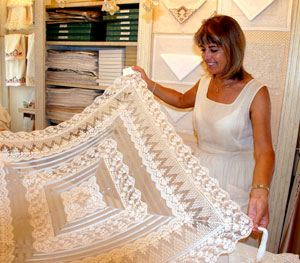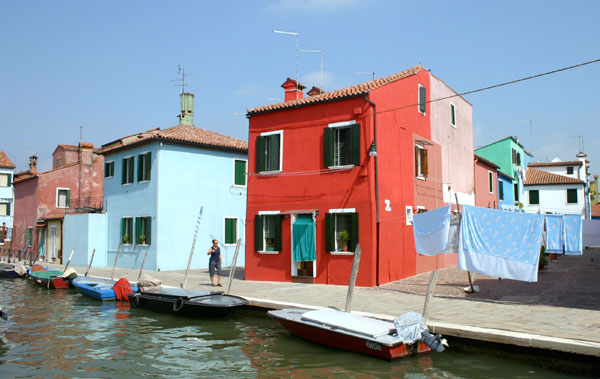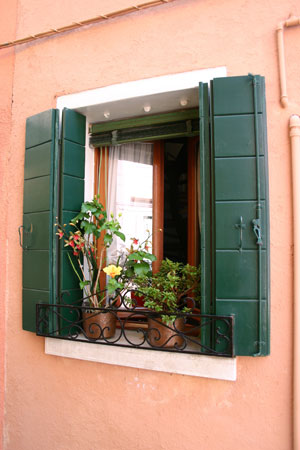BURANO, ITALY - We rushed to catch the early morning ferry to Burano, one of Venice’s enchanting out islands, but were lost in the maze of alleys leading to Fondamenta Nuovo pier, the boat’s launching point.
We stopped an elderly man and asked for directions but he could barely speak English. Using universal sign language, he instructed us to turn right at the old church on the next corner and keep walking until we came to the “porta.”
We ran until the choppy waters came into view. The last boarding announcement was being made so we rushed and jumped on the ferry that would take us to three islands that, in Italy, are just as famous as Venice.

Above: Murano is an island off Venice famous for lace.
Murano, the glass blowing island; Burano, where delicate lace garments have been made for centuries; and Torcello, a storehouse of history featuring old churches and ruins, were are destinations. Along the way, we passed the historic cemetery island San Michele, where only the dead are allowed to live.
We paid our 6 euros ($10) – the one-way fare - but later were told we should have bought a 24-hour pass for about $15 that would allow us all-day use of the ferries and waterbuses that patrol the waters around Venice. Next time, we thought.
First stop, Murano, home to Venice’s famed glass-making industry since 1291. Glass production was moved to Murano Island from the main part of Venice because its production posed a fire hazard. The buildings in Venice at the time were constructed mostly of wood and the extreme heat required to make glass liquid used to mold and shape glass obviously caused Venetians some concern.
Tourists have been rejoicing the decision ever since because it allows them to escape the chaos of Venice for the idyllic island. Just to show how important glass making was throughout Italy’s history, daughters of Murano’s biggest glassmaking families were allowed to marry into Venetian nobility in the 14th century. Glass artisans were also allowed to carry swords and enjoyed immunity from prosecution, a rarity in the Venetian city state of the Middle Ages and the Early Renaissance. During later centuries, Venetians began building vacation homes on Murano Island because the fire from the kilns was deemed to provide healthy benefits.

Above: Murano's canals are lined with some colourful homes.
Murano looks like a miniature Venice complete with its own network of canals. There are a number of museums that honor and preserve the island’s glass blowing roots, the most impressive of which is the Museo Vetraio. The museum is open every day except for Wednesday. There is also a modern and contemporary museum which features current glass art. If you want to see Murano glass in action head over to the Church of Saints Mary and Donato, originally dedicated to the Virgin Mother, where magnificent mosaic pavement dating back to the 12th century is on display.
The Murano Palazzo Mula is a wonderful place to wander – a place where small boutiques offer glass creations and quaint cafes pour delightful glasses of Italian wine.
After a few hours, its back to the pier where we catch the ferry for Burano, the place they’ve been making lace products since the 15th century.
As the ferry pulled up to Burano’s dock, the town looked more like a Mediterranean fishing port, complete with pastel color homes, than a lace town. Later we are told not everyone Burano makes lace - some fish.
Most of their catch is served up at trendy little spots like Trattoria al Gatto Nero, a café-style eatery that sits alongside the town’s main canal, Pescheria. Do yourself a favor and order the golden fried fish platter that comes swimming in a delicious tarter sauce.
The main square in Burano is lined with people selling lace products – some made in China! To make sure you purchase the real thing, take one of the side streets off the main square and head for local shops that distinguish themselves from the foreign products by their price tags.

Above: No one locks their windows on Murano.
Quality lace does not come cheap in Burano, especially at a local landmark called L'Estrosa-Burano. The lovely little shop at 423 S. Mauro is run by a mother-daughter team who are only too willing to share their knowledge of the trade with you.
Vanna de Irossi's sand-colored shop is filled with historical pieces and some creative new designs that satisfy the taste of people like actors Elizabeth Taylor and Nicolas Cage, both regular clients whom Vanna ships goods to every so often.
Vanna is the latest in a long line of Quintavalle family members who have been making and designing lace products in Burano since 1625. Small, weathered pieces of lace hang in the shop and many other family creations adorn the walls of Italy’s major museums. A lace hankie made in 1790, and which at one time belonged to Italy's Queen Margarita, is Vanna’s most prized possession. Other pieces date back to 1750.
Vanna, who runs the shop with her charming daughter Marta, tells a stranger that while it takes thousands of knots to create a single lace product, there are only 12 basic stitches used by lace makers. However, if a piece, no matter how big or small, requires 12 stitches, then 12 different lace makers work on it. Pieces like table runners take up to 15 days to make. The work is so precise that the lace makers work only four hours a day.
Vanna uses over 5,000 designs passed down through generations to make her museum-quality pieces, which consist of a 600-thread count. Just like any artist, Vanna signs her delicate creations and they quickly become family heirlooms.
Our final stop was the charming island Torcello, which has been around for 1,500 years. It was here that mainlanders escaped invading barbarians and where Ernest Hemingway holed up while writing "Across the River and Into the Trees" between duck hunting and bottles of wine with Giuseppe Cipriani—the founder of Locanda Cipriani, the island's famous inn and restaurant, and then owner of the Venice cornerstone Harry's Bar.
The most concrete relic left from Torcello's past is the Basilica of Santa Maria Assunta, which dates back to 639. It’s just a short walk from the ferry terminal. Rebuilt in the 11th century, the cathedral's interior, with its Byzantine wood beams separating brick archways supported by columns with Corinthian capitals, seems to sum up the mood of Torcello: refined simplicity and intricate attention to detail.
It’s a 40-minute return trip to Venice from Torcello so we headed back to the pier and caught the last ferry. The day ended with the islands silhouetted in the setting sun. What a great way to end a great day.
Information
- Vanna'a shop is called L'Estrosa-Burano and is located at 423 S. Mauro. You can contact her by E-mail at quintavallemarta @ libero.it or call 041-735612.
- The Trattoria al Gatto Nero is closed on Mondays and is located at 88 via Giudecca. For information, go to www.gattonero.com.
About the Author
Marc Atchison is a veteran journalist and a seasoned traveller with more than 20 years of travel writing experience. As the former Travel Editor of the Toronto Star, Canada's largest newspaper, and now Editor-in-Chief and Senior Writer for TraveLife magazine (Canada) and travelife.ca, Marc has been to over 100 countries in the world. Japan is one of his favorite destinations and he's been there on numerous occasions.